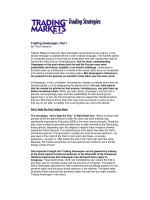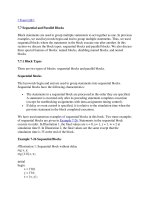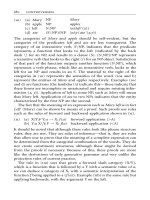Tài liệu Special Functions part 7 pdf
Bạn đang xem bản rút gọn của tài liệu. Xem và tải ngay bản đầy đủ của tài liệu tại đây (151.76 KB, 5 trang )
236
Chapter 6. Special Functions
Sample page from NUMERICAL RECIPES IN C: THE ART OF SCIENTIFIC COMPUTING (ISBN 0-521-43108-5)
Copyright (C) 1988-1992 by Cambridge University Press.Programs Copyright (C) 1988-1992 by Numerical Recipes Software.
Permission is granted for internet users to make one paper copy for their own personal use. Further reproduction, or any copying of machine-
readable files (including this one) to any servercomputer, is strictly prohibited. To order Numerical Recipes books,diskettes, or CDROMs
visit website or call 1-800-872-7423 (North America only),or send email to (outside North America).
CITED REFERENCES AND FURTHER READING:
Abramowitz, M., and Stegun, I.A. 1964,
Handbook of Mathematical Functions
, Applied Mathe-
matics Series, Volume 55 (Washington: National Bureau of Standards; reprinted 1968 by
Dover Publications, New York), Chapter 9.
Hart, J.F., et al. 1968,
Computer Approximations
(New York: Wiley), §6.8, p. 141. [1]
6.6 Modified Bessel Functions of Integer Order
The modified Bessel functions I
n
(x) and K
n
(x) are equivalent to the usual
Bessel functions J
n
and Y
n
evaluated for purely imaginary arguments. In detail,
the relationship is
I
n
(x)=(−i)
n
J
n
(ix)
K
n
(x)=
π
2
i
n+1
[J
n
(ix)+iY
n
(ix)]
(6.6.1)
The particular choice of prefactor and of the linear combination of J
n
and Y
n
to form
K
n
are simply choices that make the functions real-valued for real arguments x.
For small arguments x n, both I
n
(x) and K
n
(x) become, asymptotically,
simple powers of their argument
I
n
(x) ≈
1
n!
x
2
n
n ≥ 0
K
0
(x) ≈−ln(x)
K
n
(x) ≈
(n −1)!
2
x
2
−n
n>0
(6.6.2)
These expressions are virtually identical to those for J
n
(x) and Y
n
(x) in this region,
except for the factor of −2/π difference between Y
n
(x) and K
n
(x). In the region
x n, however, the modified functions have quite different behavior than the
Bessel functions,
I
n
(x) ≈
1
√
2πx
exp(x)
K
n
(x) ≈
π
√
2πx
exp(−x)
(6.6.3)
The modified functions evidently have exponential rather than sinusoidal
behavior for large arguments (see Figure 6.6.1). The smoothness of the modified
Bessel functions, once the exponentialfactor isremoved, makes a simple polynomial
approximation of a few terms quite suitable for the functions I
0
, I
1
, K
0
,andK
1
.
The following routines, based on polynomial coefficients given by Abramowitz and
Stegun
[1]
, evaluate these four functions, and will provide the basis for upward
recursion for n>1when x>n.
6.6 Modified Bessel Functions of Integer Order
237
Sample page from NUMERICAL RECIPES IN C: THE ART OF SCIENTIFIC COMPUTING (ISBN 0-521-43108-5)
Copyright (C) 1988-1992 by Cambridge University Press.Programs Copyright (C) 1988-1992 by Numerical Recipes Software.
Permission is granted for internet users to make one paper copy for their own personal use. Further reproduction, or any copying of machine-
readable files (including this one) to any servercomputer, is strictly prohibited. To order Numerical Recipes books,diskettes, or CDROMs
visit website or call 1-800-872-7423 (North America only),or send email to (outside North America).
0
1
2
3
4
01234
modified Bessel functions
x
K
0
K
1
K
2
I
0
I
1
I
2
I
3
Figure 6.6.1. Modified Bessel functions I
0
(x) through I
3
(x), K
0
(x) through K
2
(x).
#include <math.h>
float bessi0(float x)
Returns the modified Bessel function I
0
(x) for any real x.
{
float ax,ans;
double y; Accumulate polynomials in double precision.
if ((ax=fabs(x)) < 3.75) { Polynomial fit.
y=x/3.75;
y*=y;
ans=1.0+y*(3.5156229+y*(3.0899424+y*(1.2067492
+y*(0.2659732+y*(0.360768e-1+y*0.45813e-2)))));
} else {
y=3.75/ax;
ans=(exp(ax)/sqrt(ax))*(0.39894228+y*(0.1328592e-1
+y*(0.225319e-2+y*(-0.157565e-2+y*(0.916281e-2
+y*(-0.2057706e-1+y*(0.2635537e-1+y*(-0.1647633e-1
+y*0.392377e-2))))))));
}
return ans;
}
#include <math.h>
float bessk0(float x)
Returns the modified Bessel function K
0
(x) for positive real x.
{
float bessi0(float x);
double y,ans; Accumulate polynomials in double precision.
238
Chapter 6. Special Functions
Sample page from NUMERICAL RECIPES IN C: THE ART OF SCIENTIFIC COMPUTING (ISBN 0-521-43108-5)
Copyright (C) 1988-1992 by Cambridge University Press.Programs Copyright (C) 1988-1992 by Numerical Recipes Software.
Permission is granted for internet users to make one paper copy for their own personal use. Further reproduction, or any copying of machine-
readable files (including this one) to any servercomputer, is strictly prohibited. To order Numerical Recipes books,diskettes, or CDROMs
visit website or call 1-800-872-7423 (North America only),or send email to (outside North America).
if (x <= 2.0) { Polynomial fit.
y=x*x/4.0;
ans=(-log(x/2.0)*bessi0(x))+(-0.57721566+y*(0.42278420
+y*(0.23069756+y*(0.3488590e-1+y*(0.262698e-2
+y*(0.10750e-3+y*0.74e-5))))));
} else {
y=2.0/x;
ans=(exp(-x)/sqrt(x))*(1.25331414+y*(-0.7832358e-1
+y*(0.2189568e-1+y*(-0.1062446e-1+y*(0.587872e-2
+y*(-0.251540e-2+y*0.53208e-3))))));
}
return ans;
}
#include <math.h>
float bessi1(float x)
Returns the modified Bessel function I
1
(x) for any real x.
{
float ax,ans;
double y; Accumulate polynomials in double precision.
if ((ax=fabs(x)) < 3.75) { Polynomial fit.
y=x/3.75;
y*=y;
ans=ax*(0.5+y*(0.87890594+y*(0.51498869+y*(0.15084934
+y*(0.2658733e-1+y*(0.301532e-2+y*0.32411e-3))))));
} else {
y=3.75/ax;
ans=0.2282967e-1+y*(-0.2895312e-1+y*(0.1787654e-1
-y*0.420059e-2));
ans=0.39894228+y*(-0.3988024e-1+y*(-0.362018e-2
+y*(0.163801e-2+y*(-0.1031555e-1+y*ans))));
ans *= (exp(ax)/sqrt(ax));
}
return x < 0.0 ? -ans : ans;
}
#include <math.h>
float bessk1(float x)
Returns the modified Bessel function K
1
(x) for positive real x.
{
float bessi1(float x);
double y,ans; Accumulate polynomials in double precision.
if (x <= 2.0) { Polynomial fit.
y=x*x/4.0;
ans=(log(x/2.0)*bessi1(x))+(1.0/x)*(1.0+y*(0.15443144
+y*(-0.67278579+y*(-0.18156897+y*(-0.1919402e-1
+y*(-0.110404e-2+y*(-0.4686e-4)))))));
} else {
y=2.0/x;
ans=(exp(-x)/sqrt(x))*(1.25331414+y*(0.23498619
+y*(-0.3655620e-1+y*(0.1504268e-1+y*(-0.780353e-2
+y*(0.325614e-2+y*(-0.68245e-3)))))));
}
return ans;
}
6.6 Modified Bessel Functions of Integer Order
239
Sample page from NUMERICAL RECIPES IN C: THE ART OF SCIENTIFIC COMPUTING (ISBN 0-521-43108-5)
Copyright (C) 1988-1992 by Cambridge University Press.Programs Copyright (C) 1988-1992 by Numerical Recipes Software.
Permission is granted for internet users to make one paper copy for their own personal use. Further reproduction, or any copying of machine-
readable files (including this one) to any servercomputer, is strictly prohibited. To order Numerical Recipes books,diskettes, or CDROMs
visit website or call 1-800-872-7423 (North America only),or send email to (outside North America).
The recurrence relation for I
n
(x) and K
n
(x) is the same as that for J
n
(x)
and Y
n
(x) provided that ix is substituted for x. This has the effect of changing
a sign in the relation,
I
n+1
(x)=−
2n
x
I
n
(x)+I
n−1
(x)
K
n+1
(x)=+
2n
x
K
n
(x)+K
n−1
(x)
(6.6.4)
These relations are always unstable for upward recurrence. For K
n
, itself growing,
this presents no problem. For I
n
, however, the strategy of downward recursion is
therefore required once again, and the starting point for the recursion may be chosen
in the same manner as for the routine bessj. The only fundamental difference is
that the normalization formula for I
n
(x) has an alternating minus sign in successive
terms, which again arises from the substitution of ix for x in the formula used
previously for J
n
1=I
0
(x)−2I
2
(x)+2I
4
(x)−2I
6
(x)+··· (6.6.5)
In fact, we prefer simply to normalize with a call to bessi0.
With thissimple modification, the recursion routines bessj and bessy become
the new routines bessi and bessk:
float bessk(int n, float x)
Returns the modified Bessel function K
n
(x) for positive x and n ≥ 2.
{
float bessk0(float x);
float bessk1(float x);
void nrerror(char error_text[]);
int j;
float bk,bkm,bkp,tox;
if (n < 2) nrerror("Index n less than 2 in bessk");
tox=2.0/x;
bkm=bessk0(x); Upward recurrence for all x
bk=bessk1(x);
for (j=1;j<n;j++) { and here it is.
bkp=bkm+j*tox*bk;
bkm=bk;
bk=bkp;
}
return bk;
}
#include <math.h>
#define ACC 40.0 Make larger to increase accuracy.
#define BIGNO 1.0e10
#define BIGNI 1.0e-10
float bessi(int n, float x)
Returns the modified Bessel function I
n
(x) for any real x and n ≥ 2.
{
float bessi0(float x);
void nrerror(char error_text[]);
240
Chapter 6. Special Functions
Sample page from NUMERICAL RECIPES IN C: THE ART OF SCIENTIFIC COMPUTING (ISBN 0-521-43108-5)
Copyright (C) 1988-1992 by Cambridge University Press.Programs Copyright (C) 1988-1992 by Numerical Recipes Software.
Permission is granted for internet users to make one paper copy for their own personal use. Further reproduction, or any copying of machine-
readable files (including this one) to any servercomputer, is strictly prohibited. To order Numerical Recipes books,diskettes, or CDROMs
visit website or call 1-800-872-7423 (North America only),or send email to (outside North America).
int j;
float bi,bim,bip,tox,ans;
if (n < 2) nrerror("Index n less than 2 in bessi");
if (x == 0.0)
return 0.0;
else {
tox=2.0/fabs(x);
bip=ans=0.0;
bi=1.0;
for (j=2*(n+(int) sqrt(ACC*n));j>0;j ) { Downward recurrence from even
m.bim=bip+j*tox*bi;
bip=bi;
bi=bim;
if (fabs(bi) > BIGNO) { Renormalize to prevent overflows.
ans *= BIGNI;
bi *= BIGNI;
bip *= BIGNI;
}
if (j == n) ans=bip;
}
ans *= bessi0(x)/bi; Normalize with bessi0.
return x < 0.0 && (n & 1) ? -ans : ans;
}
}
CITED REFERENCES AND FURTHER READING:
Abramowitz, M., and Stegun, I.A. 1964,
Handbook of Mathematical Functions
, Applied Mathe-
matics Series, Volume 55 (Washington: National Bureau of Standards; reprinted 1968 by
Dover Publications, New York),
§9.8. [1]
Carrier, G.F., Krook, M. and Pearson, C.E. 1966,
Functions of a Complex Variable
(New York:
McGraw-Hill), pp. 220ff.
6.7 Bessel Functions of Fractional Order, Airy
Functions, Spherical Bessel Functions
Many algorithms have beenproposed for computing Bessel functions offractional order
numerically. Most of them are, in fact, not very good in practice. The routines given here are
rather complicated, but they can be recommended wholeheartedly.
Ordinary Bessel Functions
The basic idea is Steed’s method, which was originally developed
[1]
for Coulomb wave
functions. The method calculates J
ν
, J
ν
, Y
ν
,andY
ν
simultaneously, and so involves four
relations among these functions. Three of the relations come from two continued fractions,
one of which is complex. The fourth is provided by the Wronskian relation
W ≡ J
ν
Y
ν
− Y
ν
J
ν
=
2
πx
(6.7.1)
The first continued fraction, CF1, is defined by
f
ν
≡
J
ν
J
ν
=
ν
x
−
J
ν+1
J
ν
=
ν
x
−
1
2(ν +1)/x −
1
2(ν +2)/x −
···
(6.7.2)









